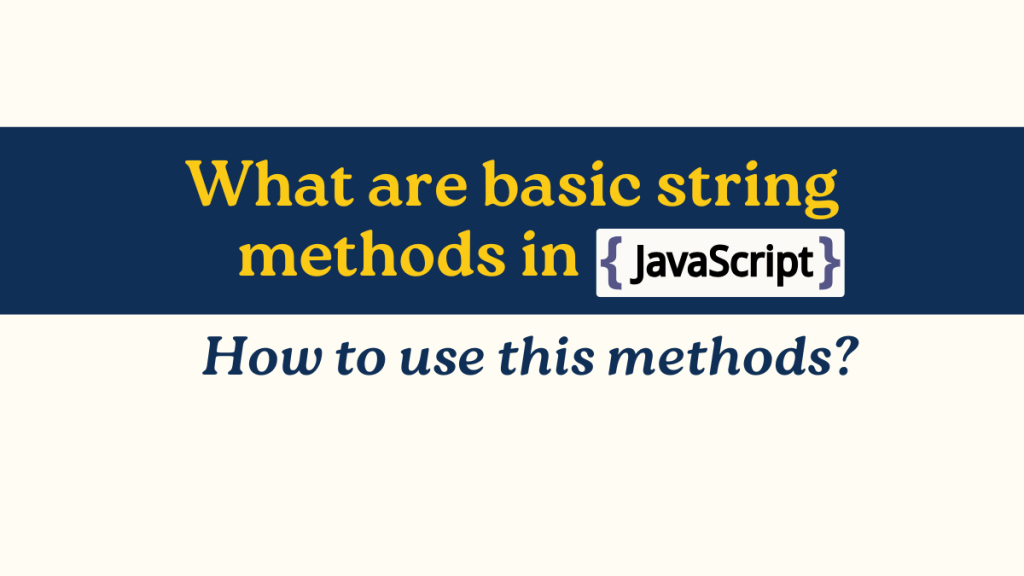
- What is a string?
- String Property and methods
- Basic String Methods
- 1. string[index] – Return an indexed character from a string.
- 2. at() – Returns an indexed character from a string.
- 3. charAt()- Returns the character at a specified index (position).
- 4. charCodeAt()- Returns the Unicode of the character at a specified index.
- 5. codePointAt() – Returns the Unicode value at an index (position) in a string
- 6. concat()- Returns two or more joined strings
- 7. fromCharCode()- method converts Unicode values to characters.
- 8. length- Property return length of string.
- 9. toLowerCase() - method converts a string to lowercase string.
- 10. toUpperCase() - method converts a string to uppercase string.
- 11. trim() - method removes whitespace from both sides of a string.
- 12. repeat() – method returns a string with a number of copies of a string.
- Final Words
What is a string?
A JavaScript string is a text that can be inside double (“text”) quotes or single (‘text’) quotes. String indexes are zero-based- The first character is (0) zero, the second is (1), and so on. Example:-
let carName1 = "Volvo XC60";
let carName2 = 'Volvo XC60';String Property and methods
In JavaScript, strings like” Mohammad” are generally considered primitive values, which do n’t have styles or parcels. However, when you access a method or property on a string, JavaScript temporarily converts it into a String object, allowing you to use various built-in methods. We can defined string in 5 categories:
- Basic String Methods
- Search & Check Methods
- Substring & Extract Methods
- Replace & Modify Methods
- Convert & Transform Methods
Today, we learn about Basic String Methods in JavaScript and How to use this methods in your code. Let’s dive into learning.
Basic String Methods
1. string[index] – Return an indexed character from a string.
Example:
const my_string = "Hello World";
console.log(my_string[3])
// output: "l"Key Points:
- The
string[index]– index is required. - It return indexed single-string character
- It give an Error when index is not specified or provide.
2. at() – Returns an indexed character from a string.
Example:
const my_string = "Hello World";
console.log(my_string.at(8))
// output: "r"Key Points:
- The
at()method returns the same asstring[index]. - The
at(index)– index is optional. The default index is 0. - It return indexed single-string character
- Return undefined if the index is out of range.
- String
at()is supported in all browsers since March 2022.
3. charAt()– Returns the character at a specified index (position).
Example:
const my_string = "Hello World";
console.log(my_string.charAt(6))
// output: "W"Key Points:
- The
charAt()method returns the same as string.at(). - The
charAt(index)– index is optional. The default index is 0. - It return indexed single-string character
- Return an empty
string ("")if the index is out of range. charAt()is an ECMAScript1 (JavaScript 1997) feature.- It is supported in all browsers.
4. charCodeAt()– Returns the Unicode of the character at a specified index.
Example:
const myString = "Hello World";
console.log(myString.charCodeAt(3))
// output: 108Key Points:
charCodeAt()returns a number between 0 and 65535.- The
charCodeAt(index)– index is optional. The default index is 0. - It converted the indexed string to a number and returned the converted number.
- Return
NaNif the index is out of range or invalid. charCodeAt()is an ECMAScript1 (JavaScript 1997) feature.- It is supported in all browsers.
5. codePointAt() – Returns the Unicode value at an index (position) in a string
Example:
const myString = "Hello World";
console.log(myString.codePointAt(4))
// output: 111Key Points:
codePointAt()is UTF-16 andcodePointAt()is Unicode.- The
codePointAt(index)– index is optional. The default index is 0. - It converted the indexed string to a number and returned the converted number.
- Return
undefinedif the index is out of range or invalid. codePointAt()is an ECMAScript6 (ES6) feature.
6. concat()– Returns two or more joined strings
Example:
const string1 = "Hello";
const string2 = "World";
const concatedString = string1.concat(" ", string2))
console.log(concatedString)
// output: "Hello World"Key Points:
- The
concat()method does not change the existing string. - The
concat()method returns a new string. - The
concat(string1, string2, …., stringX)– the strings required for strings to be joined. concat()is an ECMAScript1 (JavaScript 1997) feature.- It is supported in all browsers.
7. fromCharCode()– method converts Unicode values to characters.
Example:
let text = String.fromCharCode(72, 69, 76, 76, 79);
console.log(text);
// Output- HELLOKey Points:
String.formCharCode()- The
String.formCharCode()is a static method of the String object. - The syntax is always
String.formCharCode(). - You cannot use it, like this:
myString.formCharCode(). - The
String.formCharCode(n1, n2, …. nX)–- At least One or more Unicode values required for converting.
String.formCharCode()is an ECMAScript1 (JavaScript 1997) feature.String.formCharCode()supported in all browsers.
8. length– Property return length of string.
Example:
let text = "Hello World!";
let length = text.length;
// Output- 11Key Points:
lengthProperty return 0 if a string is empty.lengthlengthis an ECMAScript1 (JavaScript 1997) feature.lengthis supported in All browsers.
9. toLowerCase() – method converts a string to lowercase string.
let text = "Hello World!";
let result = text.toLowerCase();
console.log(result);
// Output: "hello world"Key Points:
toLowerCase()method don’t change the main string.toLowerCase()toLowerCase()toLowerCase()
10. toUpperCase() – method converts a string to uppercase string.
let text = "Hello World!";
let result = text.toUpperCase();
console.log(result);
// Output: "HELLO WORLD"Key Points:
toUpperCase()method don’t change the main string.toUpperCase()toUpperCase()toUpperCase()
11. trim() – method removes whitespace from both sides of a string.
let text = " Hello World! ";
console.log(text.trim());
// Output: "Hello World"Key Points:
trim()method don’t change the main string.trim()returns a new string.trim()is an ECMAScript5 (ES5) feature.trim()is supported in all browsers.
12. repeat() – method returns a string with a number of copies of a string.
let text = "Hello World!";
let result = text.repeat(2);
// Output: 'Hello World!Hello World!'Key Points:
repeat()method don’t change the main string.repeat()- The
repeat(count/number) repeatrepeat
Final Words
These 12 string methods are some of the most commonly used tools in JavaScript — whether you’re slicing, searching, trimming, or transforming strings, they’ll be your go-to solutions in real-world projects.
If you’re just getting started, mastering these methods is a huge step forward toward writing cleaner, smarter, and more efficient code.
💬 Still confused about any of the methods above?
Drop a comment below, and I’d be happy to explain it in a simpler way — we learn better when we learn together!
For more information please visit W3School







Leave feedback about this